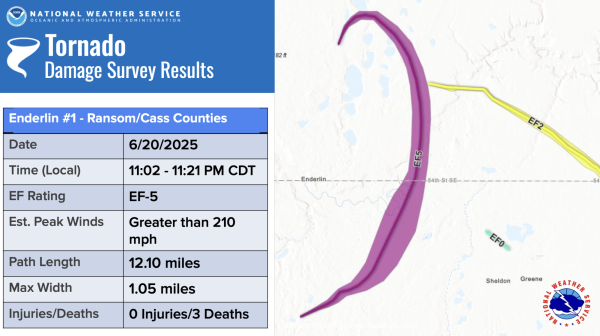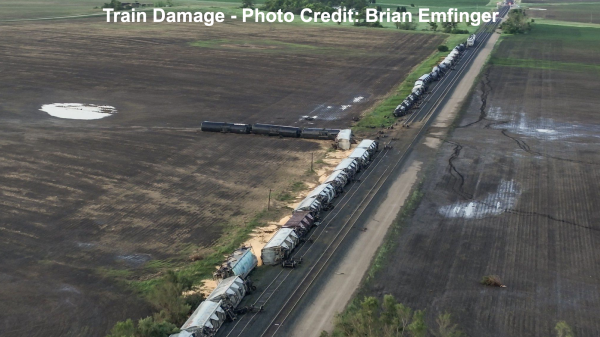On June 20th, 2025, a mile wide tornado touched down at 11:02 pm near the small town of Enderlin, North Dakota. The nighttime wedge wreaked havoc on the North Dakota countryside for 19 minutes before dissipating at 11:21pm, traveling approximately 12 miles. The tornado took the lives of three people, the deadliest in North Dakota since 1978.
The Enderlin Tornado’s path is in dark purple (via NWS Grand Forks)
The National Weather Service (NWS) office in Grand Forks surveyed the damage, and gave the tornado an EF3 rating with peak winds of 160 mph back in June.
However, on October 6, 2025 the NWS office in Grand Forks with the help of several engineers upgraded the rating from EF3 to EF5, now with peak winds of over 210 mph, in a re-survey of the damage, primarily from the derailment of a train. In a public information statement from the office, they stated,
“The National Weather Service in Grand Forks conducted additional surveys and worked extensively with wind damage experts to further investigate the 20 June 2025 Enderlin, ND tornado #1. The estimated maximum wind speed of the Enderlin, ND tornado #1 is greater than 210 mph and occurred during the time of the train derailment south of Enderlin, ND. The analysis involved forensic damage wind speed estimates for tipping several fully-loaded grain hopper cars and lofting of tanker cars, including one empty tanker car that was tossed about 475.5 ft (145 m). The maximum wind speed also correlates to the maximum strength on the WSR-88D Storm-Relative Velocity data from KMVX.”
Train Damage from the tornado (photograph by Brian Emfinger)
This upgraded rating to EF5 marks the first tornado to receive the rating since the May 20th, 2013, Moore, Oklahoma EF5, ending the longest drought between EF5 ratings.
The rating scale on which tornados are assessed is the Enhanced Fujita scale, developed back in 2007 as a revised version from the original Fujita scale, introduced by Dr. Ted Fujita back in 1971.
The Enhanced Fujita scale rates tornado intensity based on the severity of the damage a tornado causes. Using different indicators of damage, engineers can survey the damage and estimate how strong a structure was and how fast the winds must have been to cause such damage.
The EF scale has been a hot topic among storm and tornado enthusiasts, as they claim that many recent tornados such as the 2021 Mayfield, KY EF4 and the 2023 Rolling Fork, MS, EF4 should have received an EF5 rating based on similar damage as seen from the Enderlin EF5.
Aftermath of the Rolling Fork EF4 (photograph from Chandan Khanna/AFP via Getty Images)
It is incredibly difficult to accurately assess a tornado’s strength when it is ongoing, as wind speeds are extremely strong, and tornadoes take chaotic paths and can change directions at an instant.
Through radar analysis, it is possible to indicate whether a tornado is weaker or stronger, but it is not always certain. That is why ratings are administered after a tornado has caused damage.
Many people now wonder if more tornadoes will be re-surveyed to potentially upgrade or change their previous ratings. The Enderlin EF5 may have opened the door to potential additional surveys on past storms.




